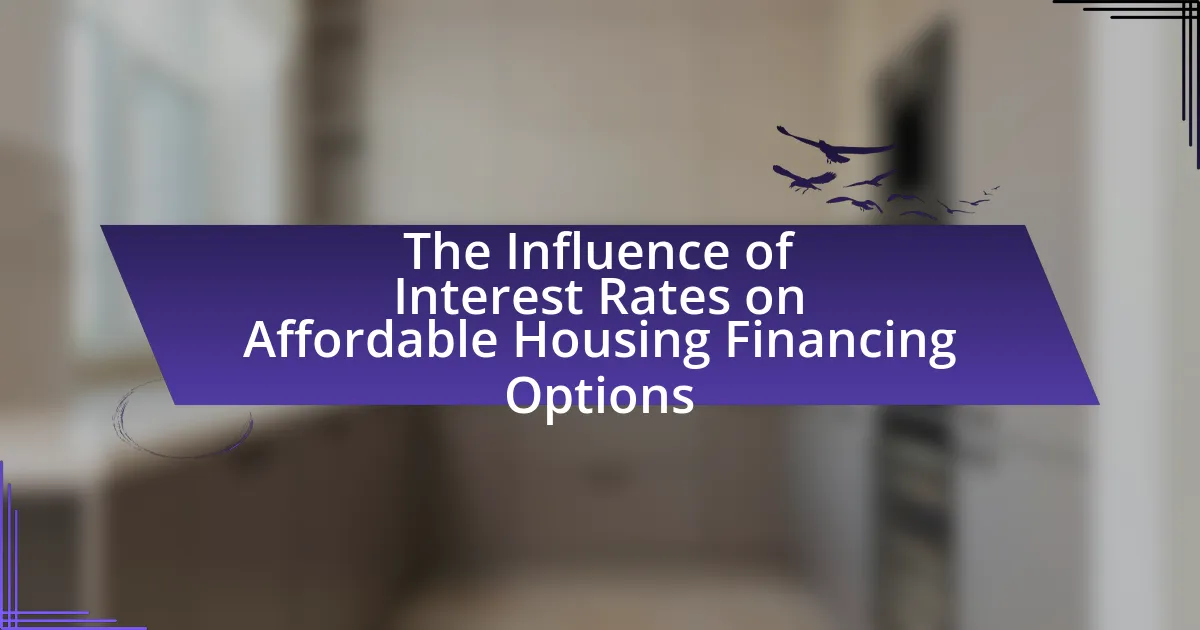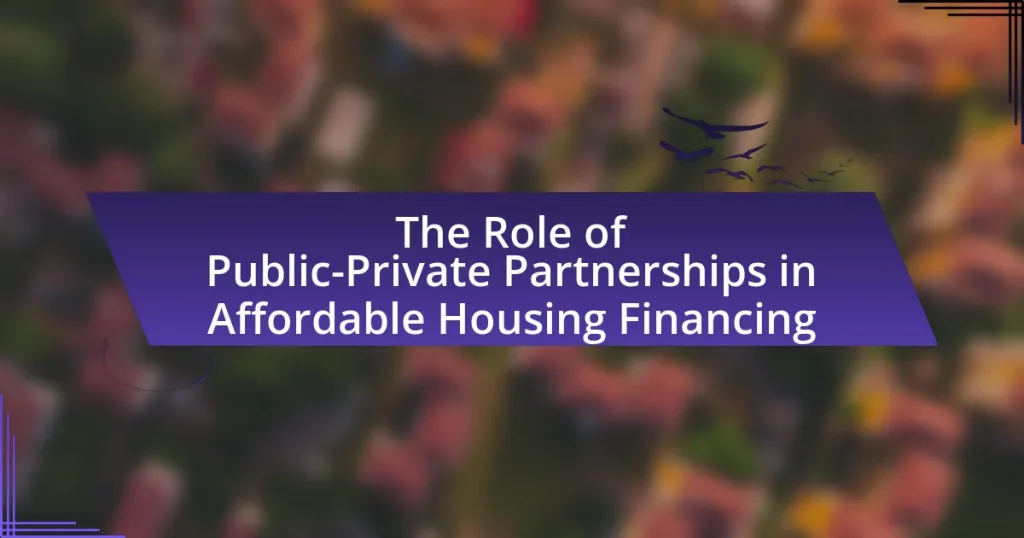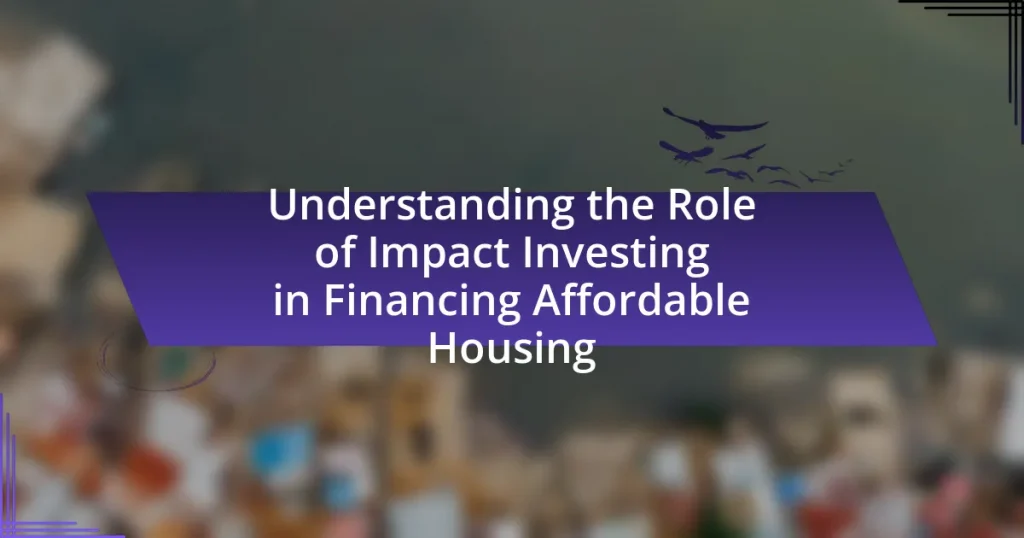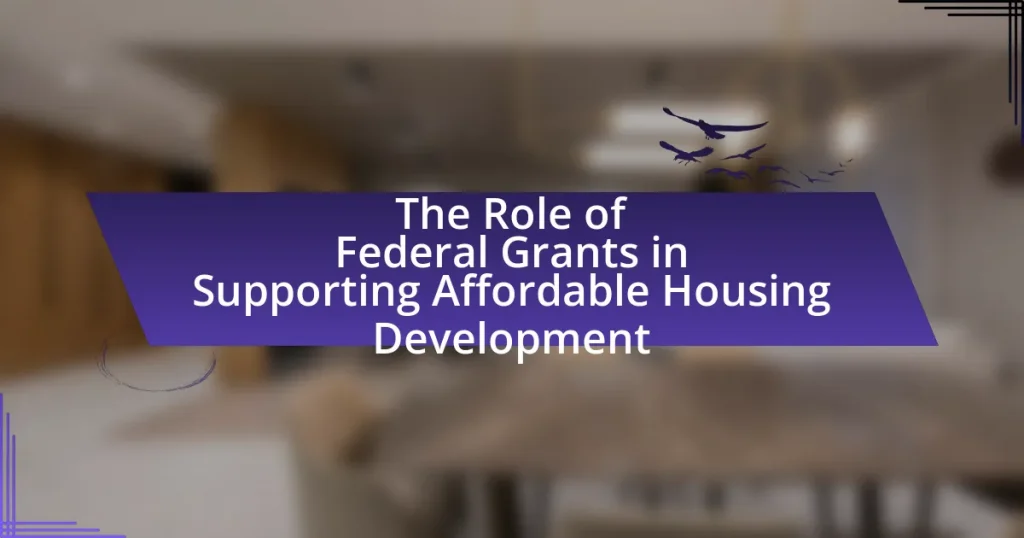Interest rates play a crucial role in shaping affordable housing financing options by directly influencing borrowing costs and overall housing affordability. When interest rates rise, the cost of mortgage loans increases, leading to higher monthly payments that can deter low-income buyers from entering the market. Conversely, lower interest rates make financing more accessible, encouraging investment in affordable housing projects. The article examines the impact of interest rate fluctuations on mortgage payments, loan accessibility for low-income families, and the availability of government subsidies, highlighting historical trends and future predictions regarding interest rates and their effects on affordable housing markets. Additionally, it discusses various financing options and strategies to mitigate the challenges posed by rising interest rates.

What is the Influence of Interest Rates on Affordable Housing Financing Options?
Interest rates significantly influence affordable housing financing options by affecting the cost of borrowing. When interest rates rise, the cost of mortgage loans increases, making it more expensive for potential homeowners to finance affordable housing. For instance, a 1% increase in interest rates can raise monthly mortgage payments by approximately 10-15%, which can deter low-income buyers from entering the housing market. Conversely, lower interest rates reduce borrowing costs, making financing more accessible and encouraging investment in affordable housing projects. Historical data shows that during periods of low interest rates, such as in the aftermath of the 2008 financial crisis, there was a notable increase in home purchases and construction of affordable housing units, demonstrating the direct correlation between interest rates and housing affordability.
How do interest rates affect the overall cost of affordable housing?
Interest rates significantly impact the overall cost of affordable housing by influencing mortgage rates and financing options. When interest rates rise, the cost of borrowing increases, leading to higher monthly mortgage payments for homebuyers. For example, a 1% increase in interest rates can raise monthly payments by approximately 10-15%, making homes less affordable for potential buyers. Conversely, lower interest rates reduce borrowing costs, allowing more individuals to qualify for loans and purchase homes, thereby increasing demand for affordable housing. This relationship is evident in historical data; during the 2008 financial crisis, low interest rates were implemented to stimulate housing markets, resulting in increased affordability and home purchases. Thus, fluctuations in interest rates directly affect the affordability and accessibility of housing options for consumers.
What are the key components of housing financing influenced by interest rates?
The key components of housing financing influenced by interest rates include mortgage rates, loan terms, and down payment requirements. Mortgage rates directly affect monthly payments; as interest rates rise, the cost of borrowing increases, leading to higher monthly payments for borrowers. Loan terms, typically ranging from 15 to 30 years, can also be impacted by interest rates, as longer terms may result in higher overall interest costs. Additionally, down payment requirements can fluctuate with interest rates; higher rates may necessitate larger down payments to secure favorable loan terms. Historical data shows that a 1% increase in interest rates can decrease home affordability by approximately 10%, illustrating the significant impact of interest rates on housing financing.
How do fluctuations in interest rates impact monthly mortgage payments?
Fluctuations in interest rates directly affect monthly mortgage payments by altering the cost of borrowing. When interest rates increase, monthly payments rise because borrowers pay more in interest over the life of the loan. For example, a 1% increase in interest rates can increase monthly payments by approximately 10-15% for a fixed-rate mortgage. Conversely, when interest rates decrease, monthly payments lower, making mortgages more affordable. Historical data shows that during the 2008 financial crisis, interest rates fell significantly, leading to reduced monthly payments and increased home affordability for many buyers.
Why are interest rates critical in determining financing options for affordable housing?
Interest rates are critical in determining financing options for affordable housing because they directly influence the cost of borrowing. When interest rates are low, the cost of loans decreases, making it easier for developers and buyers to finance affordable housing projects. Conversely, high interest rates increase borrowing costs, which can limit the availability of financing and reduce the number of affordable housing units that can be developed. For instance, a 1% increase in interest rates can significantly raise monthly mortgage payments, impacting affordability for potential homeowners and the overall feasibility of housing projects. This relationship underscores the importance of interest rates in shaping the landscape of affordable housing financing.
What role do interest rates play in the accessibility of loans for low-income families?
Interest rates significantly impact the accessibility of loans for low-income families by determining the cost of borrowing. Higher interest rates increase monthly payments, making loans less affordable for these families, who often have limited financial resources. For instance, a study by the Federal Reserve Bank of New York found that a 1% increase in interest rates can reduce loan affordability by approximately 10%, disproportionately affecting low-income borrowers. Consequently, when interest rates rise, low-income families face greater challenges in securing loans, which can hinder their ability to purchase homes or invest in necessary improvements.
How do interest rates influence the availability of government subsidies for housing?
Interest rates significantly influence the availability of government subsidies for housing by affecting the cost of borrowing and the overall economic environment. When interest rates are low, borrowing costs decrease, making it easier for individuals and developers to finance housing projects, which can lead to increased demand for government subsidies to support affordable housing initiatives. Conversely, high interest rates raise borrowing costs, potentially reducing the number of housing projects and the need for subsidies, as fewer developers may pursue new projects due to financial constraints. Historical data shows that during periods of low interest rates, such as in the aftermath of the 2008 financial crisis, government subsidies for housing increased to stimulate the market, demonstrating the direct correlation between interest rates and subsidy availability.
What trends can be observed in interest rates and their impact on affordable housing?
Interest rates have been trending upward in recent years, which negatively impacts affordable housing by increasing borrowing costs for both developers and homebuyers. As interest rates rise, mortgage rates typically follow, making it more expensive for individuals to finance home purchases. For instance, the average 30-year fixed mortgage rate increased from around 3% in early 2021 to over 6% by late 2022, leading to a significant decline in housing affordability. This increase in costs can deter potential buyers from entering the market, exacerbating the affordable housing crisis. Additionally, higher interest rates can limit the ability of developers to finance new affordable housing projects, further constraining supply.
How have historical interest rate changes affected affordable housing markets?
Historical interest rate changes have significantly impacted affordable housing markets by influencing borrowing costs and housing demand. For instance, when interest rates are low, as seen during the 2008 financial crisis when the Federal Reserve lowered rates to near zero, mortgage affordability increases, leading to higher demand for housing. Conversely, when interest rates rise, such as during the late 1970s and early 1980s when rates peaked above 18%, the cost of borrowing escalated, resulting in decreased demand and stagnation in affordable housing development. These fluctuations directly correlate with housing market dynamics, as evidenced by the National Association of Realtors reporting that a 1% increase in interest rates can reduce home affordability by approximately 10%.
What predictions can be made about future interest rates and housing affordability?
Future interest rates are predicted to stabilize or gradually decrease, which may improve housing affordability. As central banks, such as the Federal Reserve, signal a potential pause or reduction in rate hikes due to inflationary pressures easing, mortgage rates could follow suit. For instance, in 2023, the Federal Reserve indicated a shift in monetary policy, leading to a decline in average mortgage rates from around 7% to approximately 6% by late 2023. This reduction can enhance affordability for homebuyers, as lower interest rates decrease monthly mortgage payments, making housing more accessible. Additionally, if economic conditions remain stable, housing supply may increase, further supporting affordability.
How do different financing options respond to changes in interest rates?
Different financing options respond to changes in interest rates in various ways, primarily affecting the cost of borrowing and overall affordability. Fixed-rate mortgages remain stable regardless of interest rate fluctuations, providing predictability in monthly payments. Conversely, adjustable-rate mortgages (ARMs) can lead to increased payments when interest rates rise, as their rates adjust periodically based on market conditions.
For example, a study by the Federal Reserve indicates that a 1% increase in interest rates can raise monthly payments on ARMs significantly, impacting affordability for borrowers. Additionally, personal loans and credit cards typically have variable interest rates, meaning their costs can rise quickly with increasing rates, further straining budgets.
In summary, fixed-rate options offer stability, while variable-rate options can lead to increased costs, directly influencing the affordability of housing financing.
What are the most common financing options for affordable housing?
The most common financing options for affordable housing include federal and state grants, low-income housing tax credits, and mortgage loans backed by government agencies. Federal and state grants provide direct funding to developers and organizations to create or rehabilitate affordable housing units. Low-income housing tax credits incentivize private investment in affordable housing by allowing investors to reduce their tax liability. Additionally, mortgage loans backed by agencies such as the Federal Housing Administration (FHA) or the U.S. Department of Agriculture (USDA) offer favorable terms to encourage the development of affordable housing. These financing options are essential in addressing the housing affordability crisis and are supported by various government programs aimed at increasing the availability of affordable housing.
How do fixed-rate and adjustable-rate mortgages differ in relation to interest rates?
Fixed-rate mortgages maintain a constant interest rate throughout the life of the loan, providing predictable monthly payments. In contrast, adjustable-rate mortgages (ARMs) have interest rates that can fluctuate based on market conditions, typically starting lower than fixed rates but subject to periodic adjustments. For example, a 30-year fixed-rate mortgage locks in a rate for the entire term, while an ARM may have an initial fixed period followed by adjustments every year or several years, depending on the terms. This difference in structure affects borrowers’ long-term financial planning and exposure to interest rate risk.
What strategies can be employed to mitigate the impact of rising interest rates on affordable housing financing?
To mitigate the impact of rising interest rates on affordable housing financing, stakeholders can employ strategies such as locking in fixed-rate mortgages, utilizing government subsidies, and exploring alternative financing options like community land trusts. Locking in fixed-rate mortgages allows borrowers to secure lower rates before increases occur, thus stabilizing monthly payments. Government subsidies, such as tax credits or grants, can help offset higher borrowing costs, making housing more affordable. Community land trusts provide a model where land is owned collectively, reducing the financial burden on individual homeowners and maintaining affordability despite rising rates. These strategies have been shown to effectively support affordable housing initiatives even in fluctuating interest rate environments.
How can potential homeowners prepare for interest rate increases?
Potential homeowners can prepare for interest rate increases by improving their credit scores and securing pre-approval for mortgages. A higher credit score can lead to better loan terms, which is crucial as rates rise; for instance, a 1% increase in interest rates can raise monthly payments significantly, impacting affordability. Additionally, obtaining pre-approval locks in a rate and provides a clearer budget, allowing homeowners to act quickly when they find a suitable property.
What best practices should lenders adopt to support affordable housing financing in a fluctuating interest rate environment?
Lenders should adopt flexible loan structures and risk-sharing mechanisms to support affordable housing financing in a fluctuating interest rate environment. Flexible loan structures, such as adjustable-rate mortgages with caps, allow borrowers to manage payments during interest rate increases, while risk-sharing mechanisms, like partnerships with government entities or non-profits, can mitigate lender exposure and enhance funding availability. Historical data shows that during periods of rising interest rates, such as the early 1980s when rates peaked above 18%, innovative financing solutions helped maintain access to affordable housing. By implementing these best practices, lenders can better navigate interest rate volatility and support sustainable housing options.



